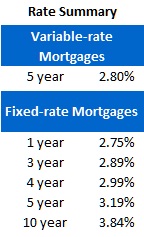David Larock in Mortgages and Finance, Home Buying
 The Bank of Canada (BoC) left its overnight rate unchanged at 1.00% last week, and also released its latest quarterly Monetary Policy Report (MPR). The MPR tells us where the BoC thinks inflation is headed and offers the Bank’s perspective on where the greatest risks to the Canadian economy lie. Regular readers of the MPR can also compare the latest report to previous versions to gauge where the BoC’s views have changed at the margin.
The Bank of Canada (BoC) left its overnight rate unchanged at 1.00% last week, and also released its latest quarterly Monetary Policy Report (MPR). The MPR tells us where the BoC thinks inflation is headed and offers the Bank’s perspective on where the greatest risks to the Canadian economy lie. Regular readers of the MPR can also compare the latest report to previous versions to gauge where the BoC’s views have changed at the margin.
For example, the BoC’s latest report said that “several significant upside and down risks are present” and that “the outlook for the global economy has deteriorated and uncertainty has increased”. This implies that the BoC sees greater volatility on the horizon and a broader range of possible outcomes ahead. The latest report predicted that “the recession in Europe would be deeper and longer than the Bank had anticipated in October” and also said that “the Bank expects the U.S. recovery will proceed at a more modest pace going forward”. Despite this, the Bank said that it now expects the Canadian economy to return to full capacity in the third quarter of 2013, which is a quarter sooner than its previous forecast.
This begs the question. If the BoC is more negative on the prospects of both Europe and the U.S., why does it also think that our economy will return to full capacity more quickly than previously expected? The BoC’s answer is that “very favourable financing conditions are expected to buttress consumer spending and housing activity… and the ratio of household debt to income is projected to rise further”.
When one considers how outspoken BoC Governor Mark Carney has been about the risks that rising debt levels pose to our economy, it was surprising to see the Bank predicting that a continued rise in our household debt levels will act as an effective counterbalance to stronger headwinds from oversees. But back to the earlier point about the broadening range of possible outcomes, the report goes on to say that our high debt levels “could lead to a sharper-than-expected deceleration in household spending”.
Five-year Government of Canada bond yields spiked at the end of last week, closing at 1.40% on Friday and finishing 14 basis points higher overall. It’s interesting that this happened at the same time that lenders finally started dropping their fixed-mortgage rates – a change that was long overdue given that gross-spread levels have been well above normal for some time (even when new lending costs are factored in). If yields continue to surge, the recent fixed-rate drops will be short lived, but I haven’t seen any obvious catalyst to suggest that this will be the case.
Variable-rate mortgage holders got some good news from the latest Consumer Price Index (CPI) released by Statistics Canada on Friday. The CPI dropped from 2.9% to 2.3% and core CPI (which excludes more volatile inputs like food and energy) also fell from 2.1% to 1.9%. The core number was below the BoC’s projection of 2.2% for Q4, 2011 and is now below the BoC’s long-term target rate of 2%. This latest round of CPI data means that the BoC can continue to take its time before raising rates, and it also vindicates the Bank’s decision last year not to raise rates when higher food and energy prices caused inflation to temporarily accelerate.
The bottom line: To paraphrase my key take-away from the BoC’s latest MPR, rising household debt levels are expected to provide the fuel needed to drive our economy through tougher times ahead, as long as no one lights a match.
David Larock is an independent mortgage planner and industry insider specializing in helping clients purchase, refinance or renew their mortgages. David's posts appear weekly on this blog (movesmartly.com) and on his own blog integratedmortgageplanners.com/blog). Email Dave



